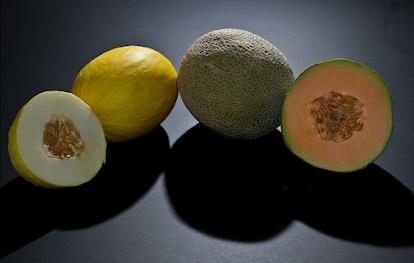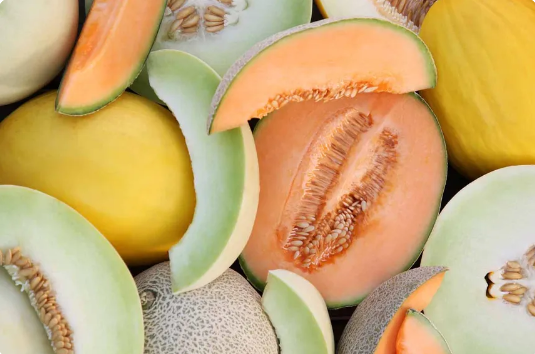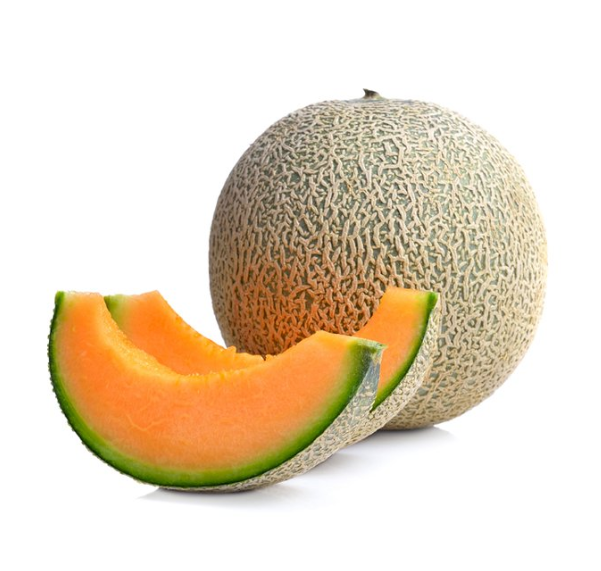Melon is a sweet and refreshing fruit that belongs to the Cucurbitaceae family, which also includes cucumbers, pumpkins, and squash. Melons are typically known for their juicy, aromatic flesh and are commonly consumed fresh, as a snack, in fruit salads, or as an ingredient in various dishes and beverages.
There are several types of melons, and some of the most popular varieties include:
1. **Cantaloupe:** Cantaloupe melons have orange flesh and a netted, rough outer rind. They are sweet and often enjoyed fresh or in fruit salads.
2. **Honeydew:** Honeydew melons have pale green flesh and a smooth, light-colored rind. They are sweet and often used in fruit salads and desserts.
3. **Watermelon:** Watermelons are large, round fruits with red or pink flesh and a green rind. They are incredibly hydrating due to their high water content and are a favorite summer fruit.
4. **Muskmelon:** Muskmelon is a generic term for various sweet melon varieties, including cantaloupe. It's often used to describe small, sweet melons with aromatic flavor.
5. **Casaba:** Casaba melons have wrinkled, yellow skin and sweet, pale green flesh. They are less common but have a unique flavor.
Melons are a good source of vitamins, particularly vitamin C and vitamin A, as well as minerals like potassium. They are low in calories and fat, making them a healthy choice for those looking to maintain or lose weight. The high water content in melons also helps keep you hydrated.
Melons are enjoyed around the world and are especially popular during the summer months due to their refreshing taste and hydrating properties.
Description
Cucumis Melo melon is an annual herbaceous plant belonging to the family Cucurbitaceae and its fruit is a pepónide berry.
Origins
The plant is native to intertropical Africa, but in East Africa, there are still some wild varieties. Its production in the Nile delta dates back five centuries to our era. The melon would later be grown in Mesopotamia, from where it arrives in Greece, and then in Italy in the 1st century BC. The Greeks then designated several sweet pulp cucurbits by the name of pepon that comes from peptein which means to cook, as if the fruit had been cooked by the sun. From there the mêlopepôn is born, then melopepo in Latin, abbreviated as melon in our language. According to Pliny the Elder, the melons of that time had the size of a quince and constituted a luxury dish consumed only by the rich Romans.
Characteristics
From the botanical point of view, the melon is a herbaceous plant with long stems that are provided with simple tendrils creeping, or climbers according to the varieties. Four types of varietals are grown mainly in our country, cantaloupe muskmelon, Italian cantaloupe (European Melon), Honeydew, and Galia. However, some non hybrid melons continue to be produced such as golden melon, charentais, cristel, among others. It's one of the largest fruits, weighing between 700 g and 4 kg. The skin varies in texture and colour (green, yellow, orange or even white), as does the pulp (from yellowish white to orange, passing through green). Along with watermelon is one of the most appetizing fruits in summer. Melon contains a lot of water, about 85%. 100 g of its pulp accounts for only about 35 calories, provides 8 g of carbohydrates, fibre (1%) and low fat (0.1%) and protein (0.6%).
Other facts
The melon digests better if it eats itself. In any case, it is not advisable to eat it or drink it too cold (as juice) as it could be excessively laxative.
Production
Overall, the annual production of melons is currently 30 million tons. The main producing countries are China, Turkey, Iran, Spain, the United States, Romania, India and Egypt. France harvests approximately 280,000 tons per year on an area of 13,500 ha, representing a yield of around 25 tons per hectare. In our country, the main melon-producing regions are Tarn and Garonne, Hérault, Charente, Deux Sèvres, Vienne and Vaucluse.



Nhận xét
Đăng nhận xét